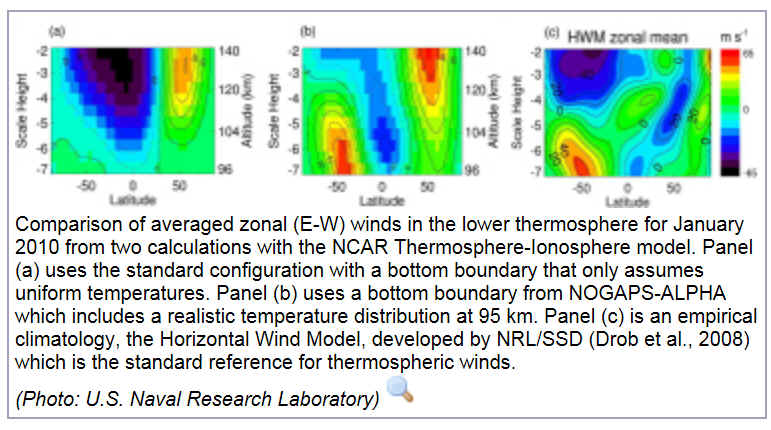|
NRL Scientists Identify New Coupling
Mode Between Stratosphere and Ionosphere
03/27/2012 13:00 EDT - NRL News Release 26-12r Scientists at the Naval Research Laboratory have identified a new mode of coupling between the stratosphere — which can drive variations at the summer mesopause — and the ionosphere, thereby establishing a new means where changes in the stratosphere can impact space weather. This research appeared in the January 6th, 2012 issue of Geophysical Research Letters.
One of the most striking characteristics of the Earth's upper atmosphere is that at the edge of space, 80 to 100 km, at polar latitudes, it is much colder in summer than winter, despite the presence of 24-hour sunlight, explains Dr. David Siskind, who works in NRL's Space Science Division and is the principal investigator for this research. Scientists have attributed this peculiar temperature reversal to the propagation of small-scale atmospheric gravity waves, which spread up from the lower atmosphere and by momentum deposition, drive the atmosphere away from a simple radiative equilibrium state. The 80 to 100 km region, which is known as the "mesopause," is so cold that ice clouds can condense in the rarefied air. These polar mesospheric clouds are being studied by a NASA mission called Aeronomy of Ice in the Mesosphere in which NRL is involved. NRL researchers are using the high-altitude extension of the Navy operational weather forecast model, NOGAPS-ALPHA (Advanced Level Physics High Altitude) to study how lower atmospheric disturbances propagate up to the thermosphere and ionosphere, above 100 km. This investigation is part of a long-term program to explore the coupling between the lower and upper atmosphere. NOGAPS-ALPHA extends up to 100 km, so the NRL team has mated the NOGAPS-ALPHA code with a community thermosphere-ionosphere model developed at the National Center for Atmospheric Research (NCAR). This NCAR model typically is forced at the bottom boundary, 95 km, by a simple averaged temperature field. The researchers first used this field to simulate lower thermospheric winds for the month of January 2010, which is the southern summer. However, when the researchers used NOGAPS-ALPHA for January 2010, the calculated thermospheric wind field throughout the entire domain changed dramatically and, in particular, the cold summer mesopause drove a fast jet stream, consistent with observational data, in the summer hemisphere between 100 and 115 km. This is similar to the wintertime lower atmosphere where the cold polar regions lead to the spin up of the wintertime polar vortex. The NRL scientists' modeling success with using the NCAR code forced by NOGAPS-ALPHA from below is significant for two reasons. First, the thermosphere is a viscous fluid. Stirring it at its base will generate a response throughout the entire domain, including those regions where the coupling to the ionosphere is important such as the tropics. So this suggests a link between the cold summer mesopause near 90 km altitude to the development of a vortex-like thermospheric wind pattern up to 115 km where space weather effects are important. Scientists believe these winds control the ionosphere at the same altitudes through ion-neutral collisions. Second, the cold summer mesopause has itself been linked in recent studies to long-term variations in stratospheric weather, including the seasonal evolution of the Antarctic ozone hole. The link here is due to the filtering of the gravity waves by the variable stratospheric winds, which then cause the summer mesopause to be cold. Bolstered by the success of their model and by the work linking the Antarctic ozone hole to the mesopause, Siskind and his research team have made the connection between this man-made disturbance of the stratosphere and the ionosphere. They conclude by suggesting that climatological studies of the ionosphere consider this link. This new coupling mechanism might furthermore have operational engineering consequences since many tables of ionospheric radio wave propagation were developed using data from the International Geophysical Year which was in the late 1950s, before the Antarctic ozone hole is believed to have opened up. About the U.S. Naval Research Laboratory The U.S. Naval Research Laboratory is the Navy's full-spectrum corporate laboratory, conducting a broadly based multidisciplinary program of scientific research and advanced technological development. The Laboratory, with a total complement of nearly 2,500 personnel, is located in southwest Washington, D.C., with other major sites at the Stennis Space Center, Miss., and Monterey, Calif. NRL has served the Navy and the nation for over 85 years and continues to meet the complex technological challenges of today's world. For more information, visit the NRL homepage or join the conversation on Twitter, Facebook, and YouTube.
|




